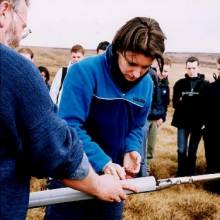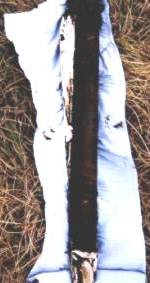Why are peat cores useful?

- The peat is anaerobic (i.e. lacking in oxygen), so pollen grains deposited by past vegetation remain preserved within it.
- Pollen grains can be identified with the aid of a microscope, thus enabling us to say which plant types once grew in or near the area.
- Deep blanket peats can preserve records of past vegetation for at least seven thousand years - This is one of the reasons why it is valuable to conserve blanket peat.

The core is taken in the field - here, the students are using a Russian corer
The samples are then taken back and analysed in the laboratory.
For more on pollen analysis (palynology) of blanket peat, see the 'Hidden history of peat' theme page
The next stop on the tour is Alport Low - how do you get there?
> Next site: 3. Alport Low.
< Previous site: 2. Alport Moor: Topography and Vegetation.
< Start of tour.
